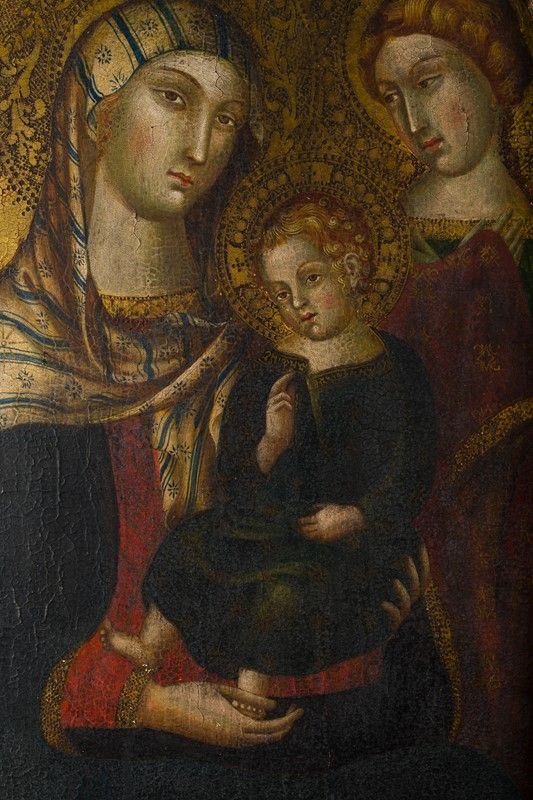7
Taddeo Di Bartolo (alla maniera di) (1422)
Madonna "Belverde"
tempera on wood
60 x 32.5 cm.
The tablet offered is strongly inspired by the famous Madonna "Belverde", preserved in the Sienese church of Santa Maria dei Servi, restored to its ancient splendor by a careful restoration carried out in 2018.
Our imitator, certainly not contemporary to the original author and who worked in a later period than the master, takes more than faithfully the composition of the fifteenth-century tablet, on the one hand by visibly embellishing the motifs of the hallmarks, on the other hand by simplifying the execution of the Virgin's mantle, as well as the one of the Child's vest. If in the "Madonna servita" the mantle is completely gilded on a complex motif of stars, birds and the word "Ave", in our table it appears in a single color, thus making the famous and rare reflection of green color disappear, which probably gave the name to Taddeo Di Bartolo's composition. Similarly for the Child, the ocher tunic and the richly decorated cloak have been replaced by a monochrome dress, here.
The dark color of the lower part is however balanced by the precious virtuosity of the punching of the haloes of the four protagonists and by the elaborate decoration of the Virgin's veil, as complex as that of the Sienese table.
We therefore think that the painting presented here was commissioned for a homely and private location: from the sixteenth century onwards, the Madonna, kept in Santa Maria dei Servi, was the object of great devotion in what was held to be the salvific responsible for the end of the plague that struck Siena in 1529. Mary's intercession was sanctioned by carrying the panel in procession through the streets, increasing its popularity. It is therefore plausible that from this moment onwards, until the end of the nineteenth century, copies of the sacred image were in great demand for worship and private devotion: despite this, at the present stage of the studies no other copies of the Madonna di Belverde, which leads to the definition of the proposed table as a very rare example.
The pictorial surface, analyzed under Wood's lamp, does not show visible repainting; the lattice of the crack has a wide groove almost in every part of the painting. Some minute drops of color are visible, concentrated at the edges of the table.
For comparisons:
L. Bellosi,"The living seemed alive": Writings of the history of Italian art of the thirteenth and fourteenth centuries , in
«Perspective», 121/124, 2006, pp . 309- 313, 308-309;
G.E. Solberg, Taddeo di Bartolo: His Life and Work , PhD thesis, New York
University, a.a. 1991, pp. 1063-1073; € 4.000,00 / 8.000,00
Estimate
€ 4.500,00
Starting price
Unsold












